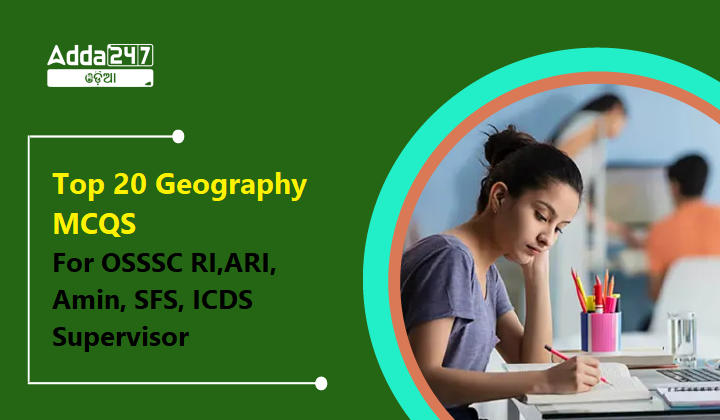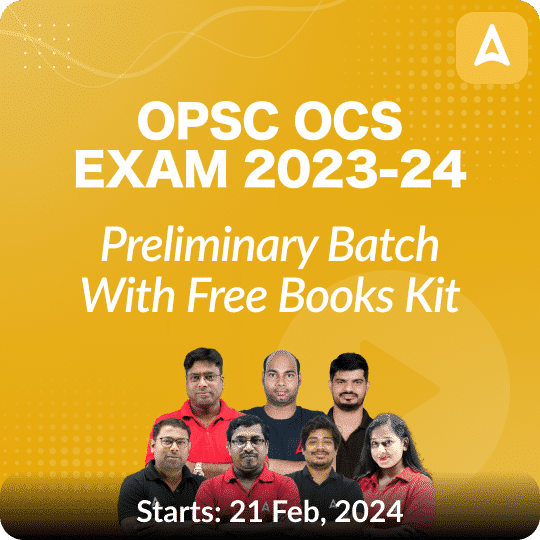Top 20 Geography MCQS For OSSSC RI,ARI, Amin, SFS, ICDS Supervisor
Preparing for competitive exams like the OSSSC RI, ARI, Amin, SFS, and ICDS Supervisor requires a solid grasp of general studies. Here are the top 20 multiple-choice questions (MCQs) along with their answers:
Q1. In which of the following city, the Hindustan machine and tool industry is located?
(a) Mumbai.
(b) Chennai.
(c) Hyderabad.
(d) Bengaluru.
S1.Ans.(d)
Sol. Hindustan Machine Tools (HMT) is an Indian state-owned manufacturing company under the control of the Ministry of Heavy Industries and ownership of the Government of India.
It was founded in 1953 as a machine tool manufacturing company, diversifying into watches, tractors, printing machinery, metal forming presses, die casting and plastic processing machinery, and CNC systems and bearings. HMT is headquartered in Bangalore.
Q2.Which of the following crops are grown mostly under subsistence farming?
(a) Millets and Rice
(b) Cotton and Tobacco
(c) Tea and Coffee
(d) Vegetables and Fruits
S2. Ans. (a)
Sol. Millets and Rice are grown mostly under subsistence farming. Subsistence agriculture is self-sufficiency farming in which the farmers focus on growing enough food to feed themselves and their families. The typical subsistence farm has a range of crops and animals needed by the family to feed and clothe themselves during the year.
Q3. Which crop is afflicted by the disease called red rot?
(a) Rice
(b) Wheat
(c) Bajra
(d) Sugarcane
S3. Ans. (d)
Sol. Red rot disease is caused by fungus and sugarcan is afficted by it.
Q4. Which one of the following soils is suitable for cotton production?
(a) Regur
(b) Red
(c) Bhangar
(d) Khadar
S4. Ans. (a)
Sol. Black soil or Regur is Suitable for cotton production.
Q5. In an area with annual rainfall of more than 200 cm and sloping hills which crop will be ideal?
(a) Jute
(b) Cotton
(c) Maize
(d) Tea
S5. Ans. (d)
Sol. In an area with annual rainfall of more than 200 cm and sloping hills will be the ideal for tea plantation.
Q6. In India more than half of the production of soyabean comes from
(a) Andhra Pradesh
(b) Madhya Pradesh
(c) Maharashtra
(d) Rajasthan
S6. Ans. (b)
Sol. Madhya Pradesh contributes more than 70% of the total soyabean production in the country.
Q7. Which is not food crop from the following?
(a) Rice
(b) Tea
(c) Maize
(d) Barley
S7. Ans. (b)
Sol. Tea is the major cash crop.
Q8. Which of the following seaport is nearest to the Rourkela steel plant?
(a) Haldia.
(b) Vishakhapatnam.
(c) Kandla.
(d) Paradip.
S8.Ans.(d)
Sol. Rourkela Steel Plant is located in Rourkela, Odisha. It is closer to Paradip port when compared with other ports. As iron is heavy and weighty, it is exported from nearby Pradip port, Odisha.
Haldia is located in West Bengal, Vishakhapatnam is located in Andhra Pradesh, and Kandla is located in Gujarat. All of these ports are further away from Rourkela than Paradip.
Q9. In which part of India is Dandakaranaya situated?
(a) Northern
(b) Eastern
(c) Central
(d) Western
S9.Ans.(b)
Sol. The region lies in the tribal belt of Orissa and Chattisgarh.
Q10. Where is kanha national park?
(a) Tamil Nadu.
(b) Bihar.
(c) Andhra Pradesh.
(d) Madhya Pradesh.
S10. (d)
Sol.
- KanhaNational park is in Madhya Pradesh.
- Also known as tiger reserve, it has wild pigs , jackal’s and tiger’s.
Q11. With which one of the following countries, India shares maximum length of the border?
(a) Bangladesh
(b) Pakistan
(c) China
(d) Nepal
S11. Ans (a)
Sol. Bangladesh shares longest border with India. Both countries share a 4,096-kilometer) long international border.
Q12. Sardar Sarovar dam is located on which river?
(a) Narmada
(b) Kaveri
(c) Tapti
(d) Krishna
S12.Ans.(a)
Sol. The Sardar Sarovar Dam is a concrete gravity dam built on the Narmada River in Kevadiya near Navagam, Gujarat. The dam was constructed to provide water and electricity to four Indian states: Gujarat, Madhya Pradesh, Maharashtra, and Rajasthan.
- India’s highest Dam is the Tehri Dam built on the Bhagirathi River.
Q13. In the Mouth, Lower Jaw is called?
(a) Maxilla
(b) Mandible
(c) Periodontal
(d) Cleft palate
S13.Ans. (b)
Sol. A jaw is a set of bones that holds your teeth, it consists of two main parts.
- The upper part is the maxilla. It doesn’t move.
- The moveable lower part is called the Mandible.
Q14. Moraines are formed in
(a) Arid regions
(b) River deltas
(c) Glacial regions
(d) Monsoon region
S14. Ans.(c)
Sol. A moraine is material left behind by a moving glacier. Just as rivers carry along all sorts of debris & silt that eventually builds up to form deltas, glaciers transport all sorts of dirt & boulders that build up to form moraines. This material is usually soil & rock.
Q15. Jet streams are usually found in the
(a) mesosphere
(b) ozonosphere
(c) tropopause
(d) ionosphere
S15.Ans.(c)
Sol. Jet streams are fast flowing, narrow air current found in the atmospheres of some planets including Earth. The main jet streams are located near the tropopause, the transition between the tropopause, the transition between the troposphere and the stratosphere.
Q16. In which of the following states is the Bhitarkanika National Park situated?
(a) Meghalaya
(b) Kerala
(c) Odisha
(d) Goa
S16. Ans. (c)
Sol. Bhitarkanika National Park is situated in Kendrapara district in Odisha. It is the 2nd Ramsar site of state. It is inundated by the rivers Brahmani, Baitarani, Dharma. Species of salt water crocodile, Indian python and king cobra are found here.
Q17. The river Ganga emerges from Gangotri Glacier and ends at _____.
(a) Arabian Sea
(b) Indian Ocean
(c) Bay of Bengal
(d) Pacific Ocean
S17.Ans.(c)
Sol. The Ganges originates from the Gangotri Glacier in Uttarakhand, and it starts as the confluence of Bhagirathi and Alaknanda river, the last part of Ganga ends in Bangladesh, where it finally converges in the Bay of Bengal.
Q18. Which one among the following is called terrestrial planet?
(a) Mercury
(b) Jupiter
(c) Saturn
(d) Uranus
S18.Ans. (a)
Sol. There are four terrestrial planets in our Solar System: Mercury, Venus, Earth, and Mars. The terrestrial planets in our Solar System are also known as the inner planets because these planets are the four closest to the Sun.
Q19. In which country is the Suez Canal located?
(a) Sudan
(b) Saudi Arabia
(c) Egypt
(d) Jordan
S19. Ans.(c)
Sol. Suez Canal is situated in Egypt. The canal connects Red Sea and Mediterranean Sea. The canal was opened in 1869 as an important medium of transportation. In 1956 the Suez Canal was nationalized by Egypt, and on 26 July 1956, Suez Canal Authority was established as a responsible body for managing issues related to the canal.
Q20. Which of the following water bodies is closest to the Palk Strait?
(a) Chilka Lake
(b) Gulf of Mahim
(c) Gulf of Mannar
(d) Gulf of Khambhat
S20.Ans. (c)
Sol. Gulf of Mannar is closest to the Palk strait. Palk strait is a strait between India and Srilanka. Gulf of Mannar is situated near Mannar Island, Sri Lanka. Palk strait and Gulf of Mannar are connected via Adam’s Bridg (Rama Setu) which is 50 km long.
















